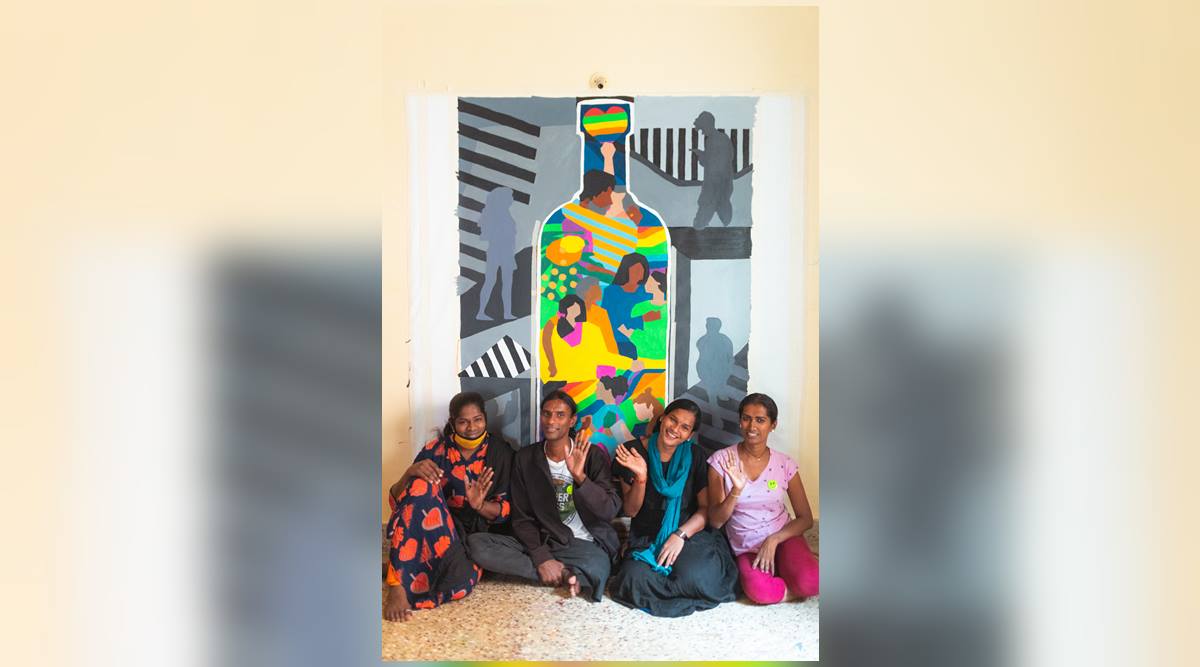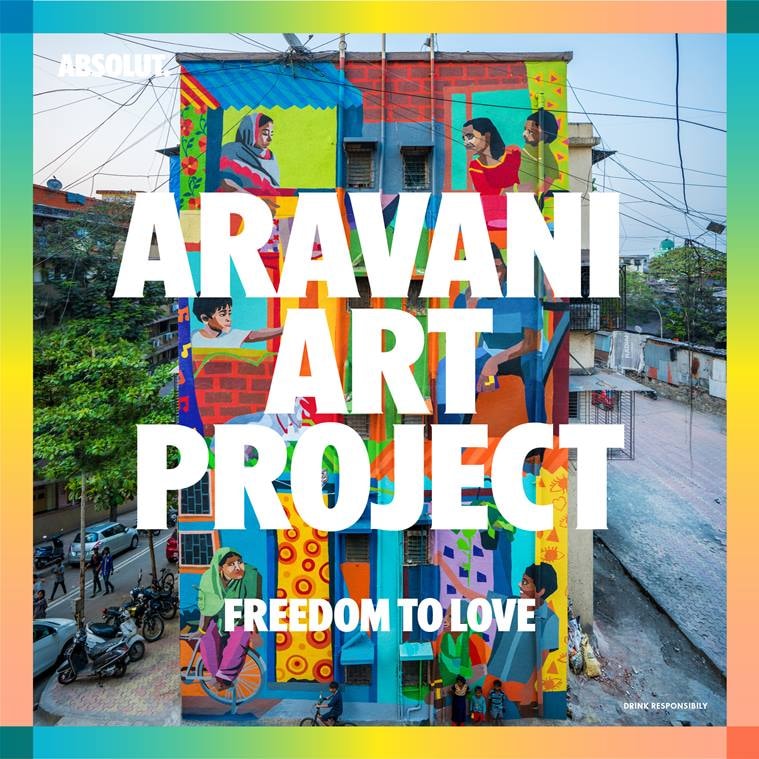 Aravani members who were part of the collaboration: Priyanka, Purushi, Kanchana and Smitha. (Photo: Vibhor Yadav - for ACC project images)
Aravani members who were part of the collaboration: Priyanka, Purushi, Kanchana and Smitha. (Photo: Vibhor Yadav - for ACC project images) From Mahim in Mumbai and KR Market in Bengaluru, to Lodhi Colony in Delhi and Sonagachi in Kolkata, in just six years, the Aravani Art Project has become a successful movement that aims to create and reclaim public spaces for members of the transgender community. They do so by using the creative and colourful medium of visual arts, and social participation.
“We intend to enable engagements for people from the transgender community to collaborate with artists, photographers, film makers and fellow society to paint large wall-murals and engage them in various forms of art to reclaim public spaces for conversations, voicing issues and commence social participation,” they say.
Recently, the collective collaborated with the Absolut Creative Commune to create a new art work that they say celebrates the power of love in all its forms. Talking about the same with indianexpress.com, the project members also opened up about their journey, the ups and downs, their artworks and future plans.
Can you tell us about the collaboration, and the artwork?
The artwork we created has gone through various renditions, but we finalised something that is very effective and celebrated the idea of ‘love is love’. Within the concept of being free and learning to break the stereotypical way to love, lies an endless ocean of freedom — it revisits the idea of having no boundaries, no conditions and no strings attached. To live free and to celebrate who you are. To love who you want.
We spend so much time chasing an idea that we ignore what’s in front of us. Love opens a whole new way of looking at things. Friendship is the most sacred form of love. Love between two men or two women is sacred. Our decision to love and whom to love is an act of freedom, and it is in this freedom that we thrive and bloom. Similarly, queer friendship and love give the reassurance of love with no condition, boundaries, gender and colour. Queer friendship makes love real, it instills a deep and resonant sense of hope, that we can change the world because look at how we’ve changed ourselves and each other.
What was the idea behind creating the same — the place, the theme, everything?
The idea was to cohesively and visually be able to depict the different ways of loving and being. We are all still unlearning and re-learning that ‘love’ is not necessarily just heteronormative and that we should have the freedom and fearlessness to celebrate all forms of ‘love’. Queer, trans, gender non-binary and folxs from various sexual and gender orientations live and experience that freedom!
View this post on Instagram
The Aravani Art Project started nearly six years ago — how would you describe the journey until today?
While the visibility of transgender people is increasing in popular culture and daily life, they still face severe discrimination, stigma and systemic inequality. With a mission of attempting to reduce this in society, we bring about change in the way the society views the transgender and queer community. We advocate the idea of reclaiming spaces in the society by creating different art projects to raise awareness and to create a voice for the community. We are finding magical ways to engage the transgender community to come out in the public spaces and feel confident, safe and belonged. Yet, the transgender people are in a constant battle as they must fight oppression, abuse and discrimination from various parts of the society, whether it’s their own family and friends or society at large.
Although our work depends heavily on community-based art grants, commissioned projects and workshops that improve the skill of the people from the community, we are in complete distraught and in disbelief of the happenings around us. We are at an interesting end and are hoping to stem new beginnings to keep life going. We have come a long way in terms of our journey, and it has been a bitter- sweet symphony.
What has been the most significant change/development since you started the art project?
Our intention to make interventions with spaces where the transgender community, live/survive and work out of, develops a sense of responsibility and self-worth. We can implement art and reach out to as many people as possible within the local communities and intertwine their journey into creating awareness, rehabilitation and inclusion, artistically. The immediate circle of people who support them and care for them become participants organically, giving us the liberty to go deeper into the conversations with the curious on-lookers.
Our work started as an expression and experiment using art and friendship as social justice activism. We started re-claiming spaces as cis- women, trans-women/men and the queer people to make a point. While we reclaimed it using art as a tool, our audiences were quite diverse, participative and enquired about everything we were doing.
To begin with, people were very open to conversations and sometimes participated during painting. This developed a sense of respect and awareness between the local communities. Our most essential part of the project is to stay in touch with the trans-community locally. Every chosen city/ town will involve the artists, women, and trans-people from that region.
 ‘The idea was to cohesively and visually be able to depict the different ways of loving and being,’ say the members of the project.
‘The idea was to cohesively and visually be able to depict the different ways of loving and being,’ say the members of the project. Over the years, art in public spaces have gained momentum and also undergone massive transformation. How, and in what ways, has the medium helped you spread your message/awareness?
We create safe spaces for the transgender community through art. We examine their spaces of innovation, the places of their history and create room to learn by transforming this knowledge into public art. The streets are a particularly important place to do our work, as it is in these public spaces where transgender identifying people face violence, harassment, social negligence and pressure. Our creative collective seeks to respond to these experiences by creating spaces that instead encourage exchange, discussion, openness, and debate surrounding gender identities.
How exactly does the project create ‘safe spaces’ for alternate voices through art?
It takes a different set of practices, thinking, training and time to allow the people from the community to understand amongst themselves that there are so many beautiful untold stories, practices, culture, way of life, traditions, songs… the list never stops. Of course, we take help from experts and people who have the skills required to do so in the most effective manner.
We intend to enable engagements for people from the transgender community to collaborate with artists, photographers, film makers and fellow society to paint large wall-murals and engage them in various forms of art to reclaim public spaces for conversations, voicing issues and to commence social participation.
View this post on Instagram
As an art collective with a social cause at its roots, what has been your biggest achievement till date?
Each and every step taken towards breaking stereotypical thinking, re-working on the stigma and reclaiming any kind of place is an achievement for us. There have been some incredible milestones along the way, we are not so tethered by the achievements as much as to be on-ground and interact with people from various backgrounds. But to name a few, we have been part of some beautiful grants and community projects that enabled us to focus on branching out into various forms of art and explore the nuances of community work on ground.
Our achievements also include successes of the transgender artists who we support and aid their mental and physical health. We are able to enable leaders within the team to take projects forward, and hopefully take over the collective and lead it.
Also, the most challenging thing you have (had) to face as a project?
There are several challenges that are always thrown at us. Our biggest challenge, right now, is finding a sustainable way of making sure the project does not wither off over time. But the persistence and, at the same time, having to keep up to date with the ever-changing world can be challenging at times. We are quite secure with the work we do, but we often think about other ways to mange ourselves financially.
On the other hand, the challenge from the community is that the older generation is very hard to change. Some members of the trans community often are misused and misunderstood if they don’t get the right guidance. Their hardships have left them very bitter and angry with the society. It requires a lot of perseverance.
View this post on Instagram
You recently also painted a mural at Mumbai’s Love Grove sewage plant — tell us about that?
It has been ongoing since February 2021, and it is always marvelous to paint and be a part of large projects in Mumbai. Our team in Mumbai is very welcoming and we love the interactions that we have had on the streets of Worli during this project. We are always looking forward to painting and enjoying the process of making art in public spaces. It makes us feel alive, and we are so happy that the people of Mumbai really appreciated and connected to this project.
What is in the pipeline/future projects?
The future is as fragile as our present. Apart from working in big cities, we would like to spread our work and workshops in smaller towns and two-tier cities, too. We are in the process of training a set of people from the transgender community to lead, teach and execute these workshops in smaller and two-tier towns. Simultaneously, we will participate and initiate trans-cultural exchanges between India and other countries.
📣 For more lifestyle news, follow us on Instagram | Twitter | Facebook and don’t miss out on the latest updates!
- The Indian Express website has been rated GREEN for its credibility and trustworthiness by Newsguard, a global service that rates news sources for their journalistic standards.

